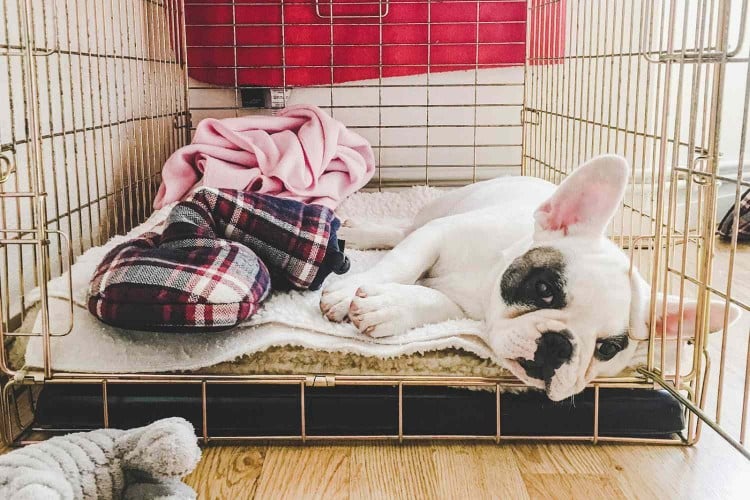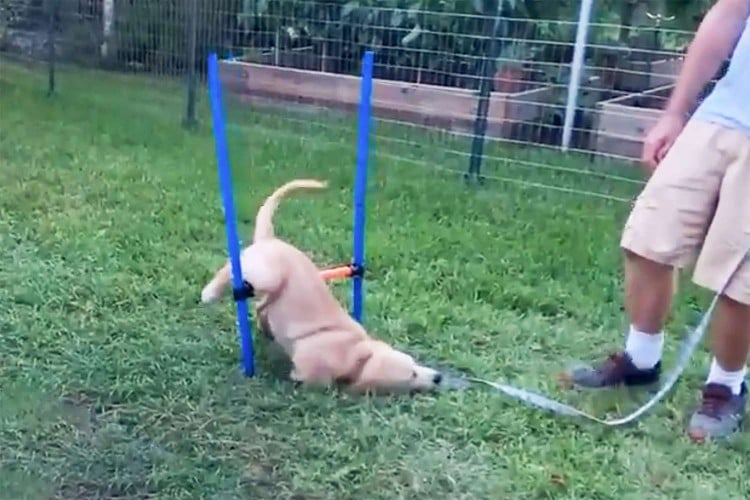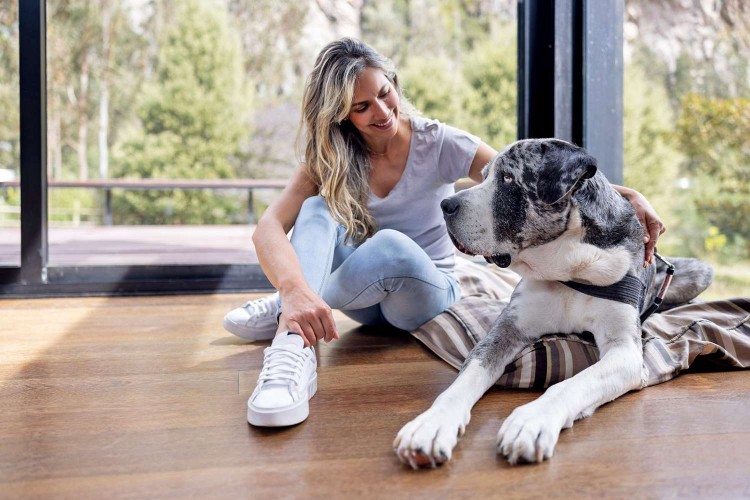To humans, crates may look like a cage. But they can become a comfortable safe space for a dog of any age—as long as they are introduced properly. Dogs often need to be crated at the vet office or the groomer, while at a boarding facility, or during travel. Crates are also crucial in case of natural disasters and other emergencies (evacuation shelters usually require dogs to be crated).
All of this means that crate training is important for every dog. Best of all: When done correctly, crate training a puppy allows you to create a safe and cozy home for her to sleep at night, while also curbing undesirable behavior so you don't wake up to gnawed-on shoes.
To walk us through how to crate train a puppy and all the benefits that come with it, we teamed up with canine expert Jen Nastanski, CPDT-KA, a behavior specialist from the American Society for the Prevention of Cruelty to Animals (ASPCA) Animal Recovery Center & Canine Annex for Recovery and Enrichment.
What Is Crate Training?
At its core, a crate is a great short-term way to train and manage your dog while building a comfortable space that makes your pup feel more secure. It can also be helpful in potty training and for limiting access to parts of the house as needed.
While crate training a puppy may take time and effort, it has benefits for dog owners, too. "A crate gives you a secure way to transport your dog and travel with her," Nastanski says. "You can also use a crate to efficiently house train your dog and prevent her from being destructive when you're not around to supervise."
When Should I Start Crate Training a Puppy, and How Do I Prepare?
"If you're using the crate for house training, remember that it's a temporary tool," Nastanski says. "Your goal is to create a dog who can be trusted to have freedom in at least part of your house while you're gone." Once that's accomplished, you can keep the crate for your dog to sleep and relax in by simply removing the door or leaving it open.
While training can be easier for younger dogs, if you go about it correctly, you can train dogs at all ages to feel comfortable in their crate.
How to Choose a Crate
Pet supply stores and online vendors sell a wide variety of crates in different sizes and materials, including plastic, wire, and mesh. Each style has its own advantages:
- Wire crates are portable and collapse for storage.
- Plastic crates are great for travel and feel especially den-like to your pup.
- Mesh crates provide privacy and are great for travel, but some dogs will chew through them.
Once you choose a crate, it's time to make it cozy. Nastanski recommends putting it in a room where you spend a lot of time but away from foot traffic. Think: a corner of your living room. Set it up with a dog bed, a blanket, and one or two toys. "You can even add a shirt you've recently worn into the crate," Nastanski suggests, to help your dog feel comforted by your scent. Draping a blanket over a wire crate can also create a more den-like feel for your pup.
Perfect Fit: Choosing the Right Crate Size for Your Dog
How to Crate Train a Puppy, Step-by-Step
Like many training techniques, getting your dog comfortable with a crate requires finding ways to make sure your pup enjoys her space.
1. Introduce Your Dog to the Crate
Once you've chosen a crate and set it up as a cozy little den for your canine friend, it's time to introduce your dog to the space—and this should be done very gradually. "You can start getting your dog comfortable with her crate by offering her yummy treats or her meals inside the crate," Nastanski suggests.
2. Reward Your Dog
Leave your dog's crate open so she can access it at all times. "Many dogs will choose to rest inside their crates even when they don't have to," Nastanski points out.
Over a few days, begin rewarding your pup when she goes into her crateon her own—it helps to have goodies like cut-up chicken, cheese, or regular ol' dog treats ready in advance. Nastanski also recommends stuffing two or three puzzle toys with dog-safe food, like plain yogurt or peanut butter, which are great for when you start to increase the length of time your dog spends in her crate.
3. Prep Her for Crate Time
Always exercise your dog before it's time to crate. Nastanski recommends 30–60 minutes of aerobic exercise, but check with your veterinarian first to make sure the activity is safe and appropriate for your dog, and avoid boring or repetitive exercise. Instead, opt for activities that exercise both your dog's brain and body, like going on a hike or practicing on an agility course. Taking your pup out for a potty break prior to crating is also essential, as younger dogs aren't able to hold it as long as adult dogs.
4. Give Her Something To Do
Continue to give your dog treats while she's inside the crate, and always leave something to chew (and check with your veterinarian on what items are safe for your dog to chew when she's alone). As you reward your dog for going into her crate, she'll learn to love the space.
5. Practice Leaving Your Dog Alone
When she's in the crate, work on closing the door and leaving the room or house for short lengths of time. As you practice this, start increasing your time away until she's OK with you leaving for a few hours at a time.
6. Start Letting Her Roam
When your dog has gone a month without any accidents inside the house and only chews what she's actually supposed to chew on, it's a good time to give her some more freedom while you're away. "But," Nastanski notes, "the right time to give your dog more freedom will depend on her individual personality."
If you're running to the store for 30 minutes, leave your dog's crate door open. If everything is peaceful when you return, start leaving her out on her own for longer periods of time until she's a pro at staying home alone.
Do's and Don'ts of Crate Training
Because crate training comes with its benefits and challenges, these do's and don'ts can help guide you through the crate training process.
- DO attach a water bottle to your dog's crate when she needs to be crated for more than two hours. You could also use a bowl, but that can make a mess.
- DON'T crate train a dog with separation anxiety or other fears and phobias—she might panic, cry, and harm herself while trying to escape the crate. Nastanski strongly recommends consulting a professional to address your dog's anxiety or fears.
- DO stay mindful of the amount of time you leave your dog in her crate. Puppies and younger dogs don't have as much bladder control, so the maximum time for an 8- to 10-week old puppy is 30–60 minutes. According to Nastanski, dogs' body systems and elimination slow down while they sleep, which is why many adult dogs can sleep all night without needing to go outside. To keep your dog healthy and happy, use the info below as a guideline for maximum crate time. If you need to crate your dog while you're at work, always make sure you have a scheduled time when your dog is out of the crate to break up the day.
- 8–10 weeks old: 30–60 minutes
- 11–14 weeks old: 1–3 hours
- 15–16 weeks old: 3–4 hours
- 17+ weeks old: 4–5 hours
- DON'T use your dog's crate as a form of punishment. "It's fine to use the crate sparingly as a brief time-out place," Nastanski says. "But your dog should have many more pleasant experiences with her crate with treats, puzzle toys, and meals to counteract any possible unpleasant associations."
- DO let your pup out of the crate if you suspect she has to go potty. This is especially true for young puppies, who can't sleep through the night without going out to relieve themselves.
- DON'T use force to remove or put your dog into her crate. In order to keep the crate as a positive space for your dog, simply lure her in and out with treats or toys.
Crate training a puppy takes time and patience. Stay focused on the end goal: giving your pup a safe, secure location to call her own. Keep in mind that just like us humans, every dog has her own unique personality, and you'll want to work with her individual needs.
Crate training one dog might take a few days or weeks, while another may need a little longer timeline to get used to her special space. Continue to show your furry friend patience and love, and she will learn the rest on her timeline—and when the going gets tough, consult with a certified dog trainer or behavior professional for support.
How Much Does Dog Training Cost? It Depends on What Your Pup Needs










Comments on " The Do's and Don'ts of Crate Training a Puppy" :